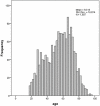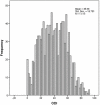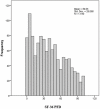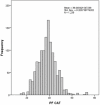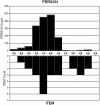PROMIS PF CAT Outperforms the ODI and SF-36 Physical Function Domain in Spine Patients
- PMID: 27792105
- PMCID: PMC5408297
- DOI: 10.1097/BRS.0000000000001965
PROMIS PF CAT Outperforms the ODI and SF-36 Physical Function Domain in Spine Patients
Abstract
Study design: The Oswestry Disability Index v2.0 (ODI), SF36 Physical Function Domain (SF-36 PFD), and PROMIS Physical Function CAT v1.2 (PF CAT) questionnaires were prospectively collected from 1607 patients complaining of back or leg pain, visiting a university-based spine clinic. All questionnaires were collected electronically, using a tablet computer.
Objective: The aim of this study was to compare the psychometric properties of the PROMIS PF CAT with the ODI and SF36 Physical Function Domain in the same patient population.
Summary of background data: Evidence-based decision-making is improved by using high-quality patient-reported outcomes measures. Prior studies have revealed the shortcomings of the ODI and SF36, commonly used in spine patients. The PROMIS Network has developed measures with excellent psychometric properties. The Physical Function domain, delivered by Computerized Adaptive Testing (PF CAT), performs well in the spine patient population, though to-date direct comparisons with common measures have not been performed.
Methods: Standard Rasch analysis was performed to directly compare the psychometrics of the PF CAT, ODI, and SF36 PFD. Spearman correlations were computed to examine the correlations of the three instruments. Time required for administration was also recorded.
Results: One thousand six hundred seven patients were administered all assessments. The time required to answer all items in the PF CAT, ODI, and SF-36 PFD was 44, 169, and 99 seconds. The ceiling and floor effects were excellent for the PF CAT (0.81%, 3.86%), while the ceiling effects were marginal and floor effects quite poor for the ODI (6.91% and 44.24%) and SF-36 PFD (5.97% and 23.65%). All instruments significantly correlated with each other.
Conclusion: The PROMIS PF CAT outperforms the ODI and SF-36 PFD in the spine patient population and is highly correlated. It has better coverage, while taking less time to administer with fewer questions to answer.
Level of evidence: 2.
Figures
References
-
- Marshall S, Haywood K, Fitzpatrick R. Impact of patient-reported outcome measures on routine practice: a structured review. J Eval Clin Pract. 2006;12(5):559–568. - PubMed
-
- McCormick JD, Werner BC, Shimer AL. Patient-reported outcome measures in spine surgery. J Am Acad Orthop Surg. 2013;21(2):99–107. - PubMed
-
- Chapman JR, Norvell DC, Hermsmeyer JT, et al. Evaluating common outcomes for measuring treatment success for chronic low back pain. Spine (Phila Pa 1976) 2011;36(21 Suppl):S54–68. - PubMed
MeSH terms
Grants and funding
LinkOut - more resources
Full Text Sources
Other Literature Sources
Medical
Research Materials
Miscellaneous

